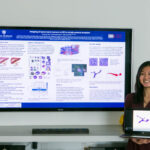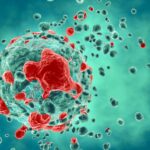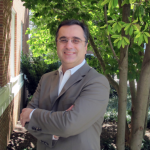Johns Hopkins Integrated Imaging Center focuses on data
Heavy, black curtains and dimmed lights shroud the core of the Johns Hopkins Integrated Imaging Center (IIC). Yet researchers who peer through the advanced microscopes cloaked by these dark draperies view experimental samples more clearly than ever thanks to a combination of the high-tech equipment and the creative expertise offered by the center’s seven-member staff.
When describing Johns Hopkins University’s showpiece microscopy facility, it’s easy to rattle off a laundry list of available equipment and laboratory space able to prepare samples with nearly any contrasting agent found in the literature. The Homewood-based center contains devices that can image a sample in virtually any manner in 2-D, 3-D and even 4-D. IIC’s 3,500 square-foot facility comprising space in Dunning, Jenkins, and Olin Halls, boasts more than $7.5 million worth of state- of-the-art imaging equipment, including a Zeiss laser scanning microscope (LSM) 510 VIS confocal with a Confocor 3 fluorescence correlation spectroscopy (FCS) module—one of only a very few such uniquely configured laser scanning microscopes in the United States.
Director J. Michael McCaffery, a research professor in the Department of Biology at the Krieger School of Arts and Sciences, said the Hopkins community is thrilled to have access to such a versatile microscope with fluorescence correlation spectroscopy that is capable of cross-correlation analysis, with confocal imaging and a fully enclosed environmental system for live imaging. Researchers affiliated with Johns Hopkins Institute for NanoBioTechnology (INBT), the Johns Hopkins Physical Sciences Oncology Center and Center of Cancer Nanotechnology Excellence are also glad to have access to IIC’s menu of facilities.
“Fluorescence correlation spectroscopy allows for high-resolution spatial and temporal analysis of single biomolecules with respect to diffusion, binding, as well as enzymatic reactions in vitro and in vivo,” McCaffery said. In other words, you can see and measure a lot of really tiny stuff with it, something INBT affiliated researchers working at micron/nanometer resolutions are finding incredibly useful.
The center features multiple suites devoted to specific microscopy/imaging functions, as well as facilities for all manner of sample preparation. All these advanced tools help scientists and engineers characterize nanomaterials; and image cells, sub-cellular organelles, and biomolecules/ proteins at very small dimensions. But none of this fancy equipment would be of much use to researchers without the expertise of McCaffery and the IIC staff. McCaffery brings years of experience and a background in cell biology and microbiology. The center’s associate director, William Wilson, an associate research professor in the Department of Materials Science and Engineering at the Whiting School of Engineering, describes himself as a “chemist, turned physicist, who became an electrical engineer, who is now a materials scientist.”
Staff scientist Kenneth J.T. Livi, director of the IIC’s High-Resolution Analytical Electron Microbeam Facility located in Olin Hall, offers his unique perspective on earth and planetary sciences. Researchers can also consult with microscopy specialist/ trained biologist and FACS supervisor Erin Pryce, the FACS manager Yorke Zhang, computer/IT specialist Marcus Sanchez, and research assistants Leah Kim and Adrian Cotarelo, who both are currently earning their bachelor degrees in biology at Johns Hopkins.
“Sometimes young researchers haven’t contemplated all the possibilities of how to use and apply an instrument; and don’t realize there are many different ways to utilize familiar tools in order to obtain new, in some cases better, information,” McCaffery said. “Our desire is always to approach a problem from many disparate perspectives to generate convergent data that corroborates each particular assay. Hopefully, results from each individual assay, allows the scientist to arrive at a convergent perspective that yields confidence in the results and conclusions.”
One of the easiest ways to obtain different microscopy data and improve corroboration among assays is simply to change the contrast mechanism.
“The most common contrast mechanisms used to image something are optical contrast (transparent versus opaque), polarization, and fluorescence,” said Wilson. “But there are many different ways you can manipulate how light interacts with the specimen and what you detect out of an objective.”
For example, ultrafast laser sources have made nonlinear optical forms of contrast an exciting new tool. Techniques like two-photon excited fluorescence and second harmonic generation (both available in the IIC) produce excellent spectral and structural information about samples because a smaller effective photon volume is excited. Wilson explained it like this: “Imagine turning your stereo all the way up and hearing the sound distorted. That distortion is created by the higher order acoustic harmonics from your stereo. The same happens with intense laser light resulting in new “colors” being generated from the object irradiated. The cool thing is that the different non-linear processes are often sensitive to different physical proper- ties or structural features, offering complementary information about your sample.”
In some cases, getting more detailed information simply requires looking at the right color range. The two-photon fluorescence and second harmonic signals appear at different wavelengths. If you excite a sample with enough energy to generate third order harmonics, that signal is detected at an even bluer wavelength, Wilson said. “With third harmonic generation, you only get signals from the interface of structures with no interference from anything else. This means you can simultaneously image fluorescence, polar order, and interface dynamics just by popping in a few filters and beam splitters,” he said.
“Over the past ten or so years, physicists and engineers focused on advanced microscopy, have produced better and more advanced laser and optical technologies, generating techniques that many researchers in the biological and biomedical sciences might not know exist,” Wilson said. “There also are a lot of applied physicists who are developing and using these new technologies who don’t know what an interesting sample is. We hope to help bridge this gap, becoming a place where these collaborative synergies can flourish.”
Sample preparation is another area where the center can help researchers. “Cell fractionation, for example, which is the breaking down of whole cells and separating them into their individual components, when combined with biochemical techniques and microscopy, can often allow researchers to pose more precise questions and to better analyze a biological problem,” McCaffery said.
“It is common for someone to come in and want to use a particular instrument or technique they read about in a paper,” McCaffery said. When that happens, McCaffery and Wilson are likely to give researchers “homework.”
“It’s important to remember that the goal is not to make a pretty picture,” Wilson said. “The goal is to answer a question, so sometimes we have to ask them, ‘What is your research question?’” An enviable set of microscopy tools combined with a team that brings years of training and experience from a variety of disciplines sets Johns Hopkins Integrated Imaging Center apart from the microscope on the individual researcher’s lab bench, as well as from facilities nationwide. Wherever possible, McCaffery said, IIC staff tries to be engaged in all of the research that is carried out in the center. “Simply, our involvement leads to better results and better science,” McCaffery added.
Researchers confirm this successful combination.
“The facilities at the IIC have allowed us to obtain critical information about the internal structure of our peptide nanomaterials that would have remained unknown without careful electron and fluorescence microscopy,” said J.D. Tovar, assistant professor of Chemistry. “Equally important, the scientific IIC staff members were vital participants making sure collaborative experiments were done meaningfully and students were trained competently. Our collaboration with Dr. Wilson has given some nice insights and at the same time has posed many more questions for future research.”
Praise like that for the IIC is always nice to hear, staff members say, but they emphasize that the services and tools they provide are just part of the job. “Part of being a scientist is learning not only how to gather information from a wide variety of tools but also understanding how to pose clear questions that lead to the right tools, in a nutshell, how to not waste time. If we can help you do that, then we have achieved our goal,” Wilson said.
This story originally appeared in Johns Hopkins Nano-Bio Magazine.
To read more about IIC’s facilities and services, go here.
Story by Mary Spiro
Photos by Mary Spiro and Marty Katz
Latest Posts
-
 Q&A with PSON Intern Jocelyn Hsu
August 19, 2021
Q&A with PSON Intern Jocelyn Hsu
August 19, 2021
-
 Start Up Founders from Johns Hopkins Aim to Stop Spread of Cancer
August 3, 2021
Start Up Founders from Johns Hopkins Aim to Stop Spread of Cancer
August 3, 2021
-
 Protein Appears to Prevent Tumor Cells from Spreading Via Blood Vessels
July 15, 2021
Protein Appears to Prevent Tumor Cells from Spreading Via Blood Vessels
July 15, 2021


